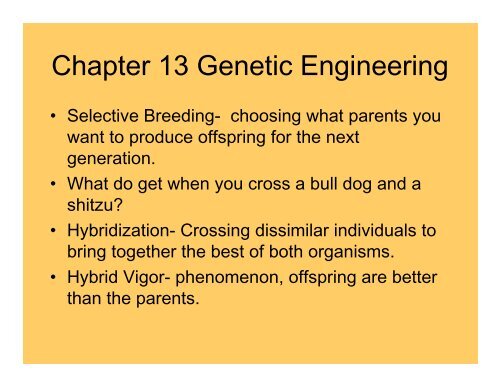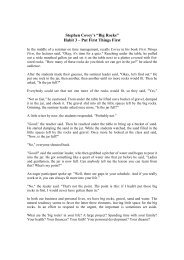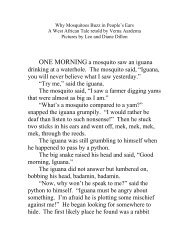Chapter 13 Genetic Engineering
Chapter 13 Genetic Engineering
Chapter 13 Genetic Engineering
Create successful ePaper yourself
Turn your PDF publications into a flip-book with our unique Google optimized e-Paper software.
<strong>Chapter</strong> <strong>13</strong> <strong>Genetic</strong> <strong>Engineering</strong><br />
• Selective Breeding- choosing what parents you<br />
want to produce offspring for the next<br />
generation.<br />
• What do get when you cross a bull dog and a<br />
shitzu?<br />
• Hybridization- Crossing dissimilar individuals to<br />
bring together the best of both organisms.<br />
• Hybrid Vigor- phenomenon, offspring are better<br />
than the parents.
• Inbreeding is the continued breeding of<br />
individuals with similar characteristics.<br />
– Risky, because it could bring out the<br />
recessive alleles and cause a genetic defect.<br />
Blindness, joint problems
Increase Variation<br />
• Why would humans want to increase<br />
variations?<br />
– Better the species<br />
– Make the mutation occur faster<br />
– More variety
Manipulating DNA<br />
• Scientist change DNA by<br />
– Extracting DNA from cells<br />
– Cut into smaller pieces<br />
– Identify the sequence of bases on the DNA<br />
molecule<br />
– Make unlimitied copies of DNA
DNA Extraction<br />
• Cells are opened up and DNA is<br />
separated from other parts of the cell
Cutting DNA<br />
• DNA is cut into small fragments by<br />
restriction enzymes. (Cuts DNA at a<br />
specific nucleotide sequence…very<br />
precise)
Separating DNA<br />
• Gel Electrophoresis- DNA Fragments are<br />
placed in certain gel wells and an electric<br />
voltage is passed through them.<br />
• DNA molecules move toward the opposite<br />
end of the gel.<br />
• Smaller DNA fragments move faster<br />
through the gel.
Using the DNA Sequence<br />
• The DNA Sequence can be read, studied,<br />
or changed.<br />
• Compare genes with other organisms.<br />
• Recombinant DNA- produced by<br />
combining DNA from different sources.
Making Copies<br />
• In order to study genes, it helps to make<br />
copies.<br />
• PCR (Polymerase Chain Reaction)-<br />
makes many copies of DNA through a<br />
process of heating and cooling using DNA<br />
polymerase.
<strong>13</strong>.4 Applications of <strong>Genetic</strong><br />
<strong>Engineering</strong><br />
• Transgenic Organisms- organisms contain<br />
genes from other organisms.<br />
– Example: The enzyme (luciferase) from fire<br />
flies was transferred into a tobacco plant cell.<br />
– What do you think happens?<br />
• The plant glows at dark…page 331
Why make transgenic organisms?<br />
• Resist pests, herbicides, harsh conditions<br />
• Improve nutritional value, shelf life<br />
• Test and study<br />
• Medical purposes…insulin, growth<br />
hormone, clotting factors<br />
• Transgenic Animals can produce more<br />
milk, less fat, human proteins
Cloning<br />
• Cloning is producing genetically identical<br />
cells from a single cell.<br />
– Bacteria is easy to clone (unicellular)<br />
– What about multicellular organisms?<br />
– Ian Wilmut cloned the first sheep. DOLLY.
Cloning Process
To Clone or Not to Clone?








